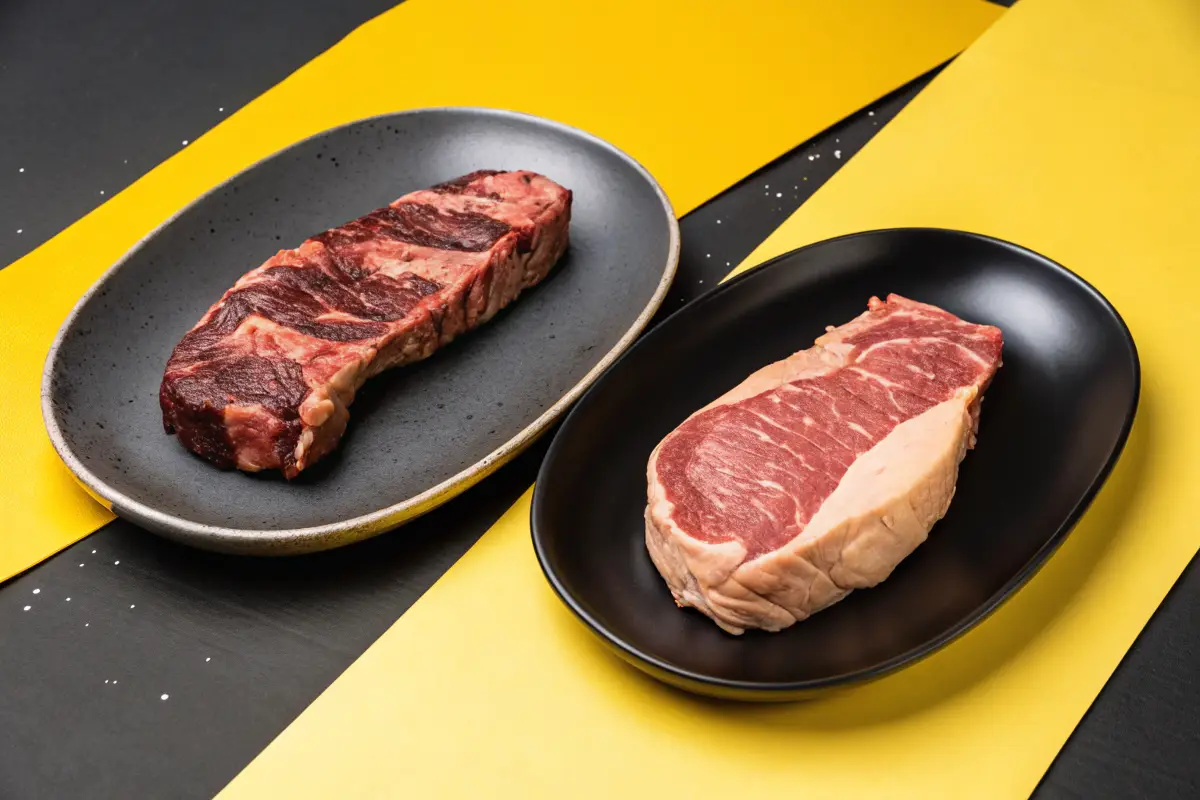Introduction: Is Ribeye Steak Better Than Filet Mignon?
When it comes to steak, two cuts dominate the conversation: ribeye and filet mignon. Both are popular, but they offer completely different experiences. Is ribeye steak better than filet mignon? That depends on what you value more—rich flavor or extreme tenderness. Before you make your next steakhouse order, it’s important to understand the key differences.
Table of contents
- Introduction: Is Ribeye Steak Better Than Filet Mignon?
- Defining and Understanding Ribeye vs. Filet Mignon
- Differences Between Ribeye Steak and Filet Mignon
- How to Cook Ribeye Steak and Filet Mignon Perfectly
- Practical Applications: When to Choose Ribeye or Filet Mignon
- Frequently Asked Questions (FAQs) About Steak Choices
- Conclusion: Which Steak Should You Choose?
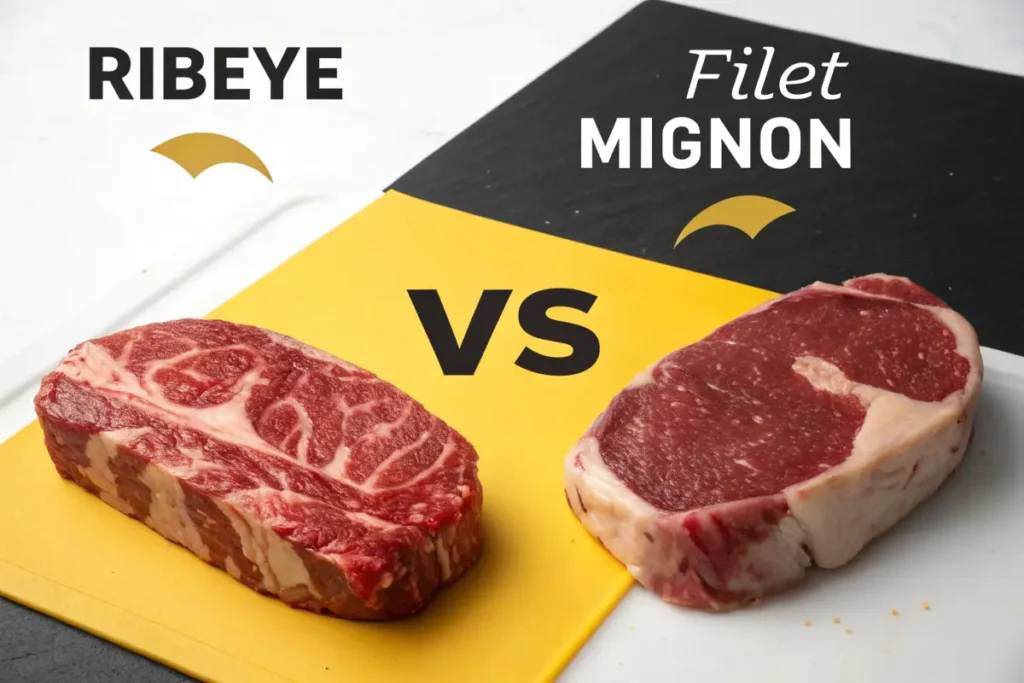
Flavor: Bold vs. Mild
First, let’s talk about flavor. Ribeye delivers an intense beefy taste because of its high-fat content. The marbling throughout the meat melts as it cooks, creating a juicy and flavorful bite. In contrast, filet mignon has a milder taste due to its low-fat content. Although it lacks marbling, its extreme tenderness makes up for it. If you love a buttery-soft texture, filet mignon is the way to go.
Cooking Methods: How They Differ
Not only do these steaks differ in texture, but they also require different cooking methods. Chefs often grill or pan-sear ribeye at high heat to develop a crispy crust while keeping the inside tender. On the other hand, filet mignon benefits from extra fat, so it’s often wrapped in bacon or served with butter to enhance its richness. Since filet is lean, overcooking it can lead to a dry texture, making precise temperature control essential.
Price: Which Steak Costs More?
Additionally, your budget matters. Ribeye usually costs less per pound than filet mignon. Since filet comes from the tenderloin, a rare and small portion of the cow, its price reflects its exclusivity. Meanwhile, ribeye comes from the rib section, which produces a more affordable yet high-quality steak.
Which One Should You Choose?
Ultimately, the best steak depends on your personal preferences. If you enjoy a bold, beefy taste, ribeye is a fantastic choice. However, if you prefer a melt-in-your-mouth texture, filet mignon won’t disappoint. No matter which one you choose, both offer a delicious experience.
Defining and Understanding Ribeye vs. Filet Mignon
When comparing ribeye vs. filet mignon, it’s important to understand what makes each cut unique. Both come from different parts of the cow, which affects their texture, flavor, and overall experience. Whether you prioritize rich marbling or supreme tenderness, knowing the key differences will help you make the best choice.
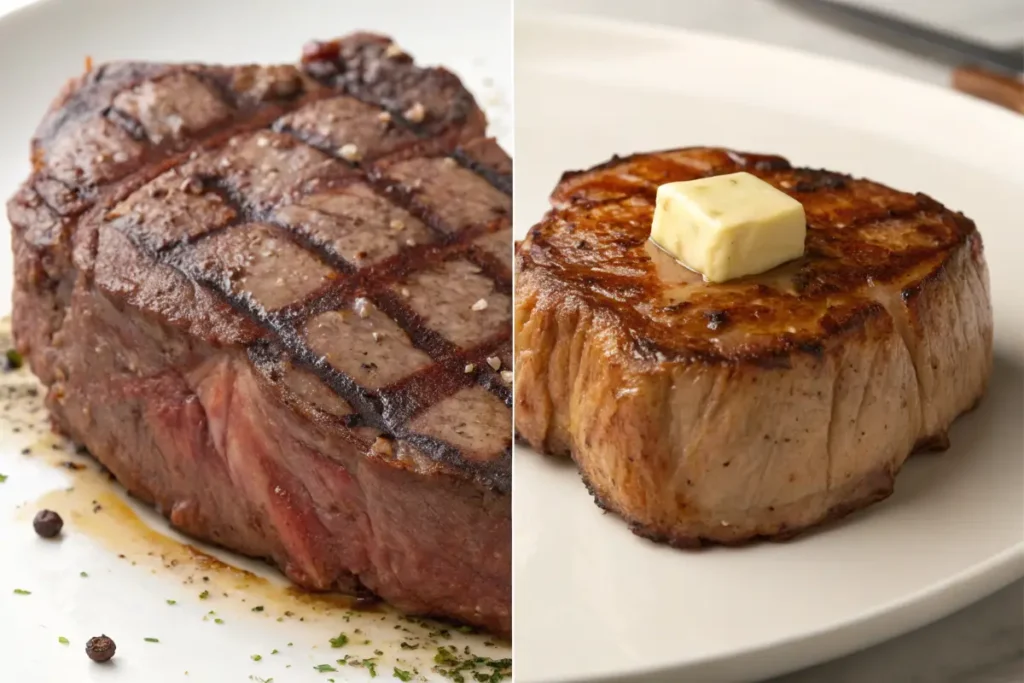
What Does Ribeye Steak and Filet Mignon Mean?
Each steak cut has a distinct origin and texture. Ribeye steak comes from the rib section of the cow, specifically from the longissimus dorsi muscle. This area doesn’t get much exercise, so the meat remains tender while developing rich intramuscular fat, also known as marbling. Because of this, ribeye is one of the most flavorful and juicy steaks.
On the other hand, filet mignon is cut from the tenderloin, a small and rarely used muscle along the spine. Since this muscle does little work, the meat becomes incredibly soft and buttery. Although filet mignon lacks the marbling found in ribeye, its silky texture makes it a luxurious choice for those who love tender steak.
Why Is Ribeye vs. Filet Mignon a Popular Debate?
Steak lovers often debate whether ribeye or filet mignon is the superior choice. The decision usually comes down to personal taste and texture preference. Some people love the bold, beefy richness of ribeye, while others prefer the delicate, melt-in-your-mouth tenderness of filet mignon.
Additionally, both steaks require different cooking techniques. Ribeye is best cooked over high heat, allowing the fat to render and create a crispy, caramelized crust. Filet mignon, on the other hand, is often pan-seared and finished in the oven to maintain its soft texture. Because it lacks fat, many chefs wrap it in bacon or serve it with butter to enhance its flavor.
Which Steak Should You Choose?
If you love juicy, flavorful, and well-marbled meat, ribeye steak is an excellent option. However, if you prefer a delicate, tender bite, filet mignon is the better choice. No matter which one you pick, both steaks offer an unforgettable dining experience.
Differences Between Ribeye Steak and Filet Mignon
Choosing between ribeye steak and filet mignon can be challenging because both have unique qualities. To make the best decision, it helps to understand their main differences, including texture, flavor, fat content, and cooking methods. Each steak offers a distinct experience, so knowing what to expect will help you pick the right one for your taste.
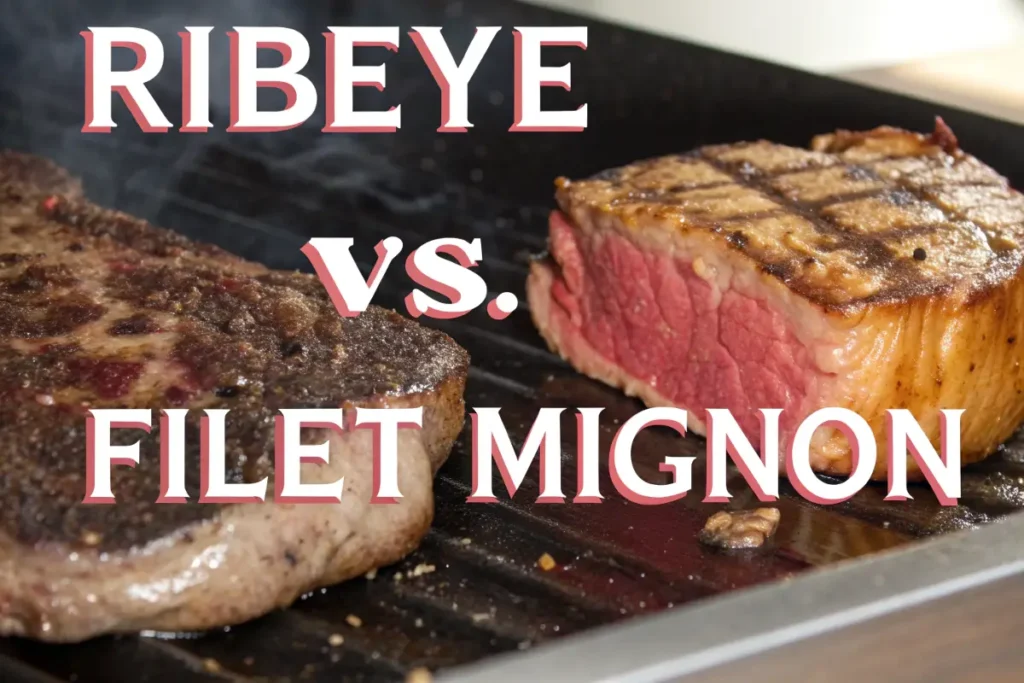
Texture and Tenderness
One of the biggest differences between ribeye steak and filet mignon is texture. Ribeye has a rich, juicy bite due to the marbling of fat throughout the meat. The fat melts during cooking, making each bite flavorful and tender. However, it is not as soft as filet mignon because of the muscle fibers present in the cut.
Filet mignon, on the other hand, is the most tender cut of beef. Since it comes from a rarely used muscle, it has an extremely soft and delicate texture. Unlike ribeye, it does not have much fat, so it lacks the natural juiciness of marbled meat. Many people enjoy filet mignon for its buttery consistency, which makes it feel like it melts in the mouth.
Flavor and Fat Content
The fat content in ribeye steak gives it a bold, rich flavor. The marbling creates a deep beefy taste that many steak lovers enjoy. When cooked properly, ribeye develops a crispy crust that enhances the overall experience. This makes it a great choice for those who appreciate a more intense and flavorful steak.
Filet mignon, in contrast, has a much milder flavor because it is lean. Without much fat, it does not have the same rich taste as ribeye. To enhance its flavor, chefs often pair it with sauces, butter, or bacon. These additions help balance the leanness of the meat while adding extra richness.
Best Cooking Methods
Cooking methods also play an important role in how these steaks taste. Ribeye is best cooked over high heat, either on a grill or in a cast-iron pan. The fat in the meat needs time to render, so it benefits from techniques like searing and resting. This allows the steak to remain juicy while developing a caramelized crust.
Filet mignon requires a more delicate approach. Since it is lean, overcooking it can make it dry. Many chefs sear it quickly on high heat before finishing it in the oven. Some prefer to cook it sous vide to maintain its perfect level of tenderness. Because it does not have much fat, it is often served with butter-based sauces to add moisture and flavor.
Choosing the Right Steak for You
Both ribeye steak and filet mignon have their advantages, so the right choice depends on personal preference. If you enjoy a juicy, flavorful steak with a rich beefy taste, ribeye is a great option. However, if you prefer a soft and tender bite with a mild flavor, filet mignon is the better choice. Regardless of which one you choose, both steaks provide a delicious and satisfying meal.
How to Cook Ribeye Steak and Filet Mignon Perfectly
Cooking ribeye steak and filet mignon requires different techniques to bring out their best qualities. Since each cut has a unique texture and fat content, choosing the right method will help you achieve the perfect steak. Whether you prefer grilling, pan-searing, or oven-finishing, understanding the correct process will make a big difference.
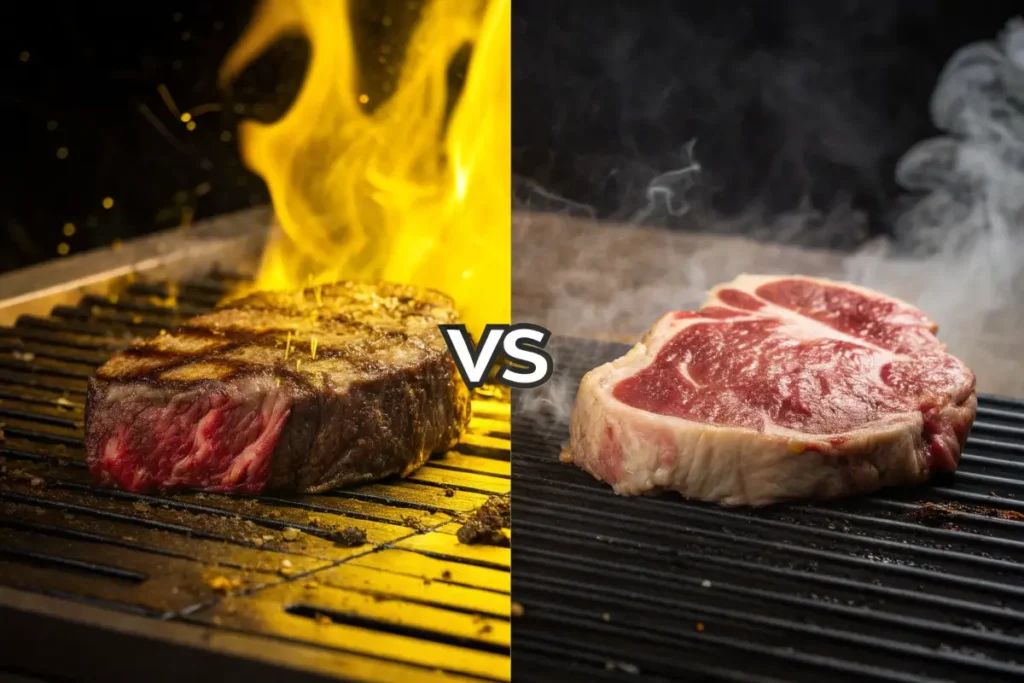
Cooking Ribeye Steak
Ribeye steak has high fat content, which makes it ideal for high-heat cooking. The fat melts as it cooks, creating a juicy and flavorful bite. Because of this, ribeye is best suited for grilling, pan-searing, or broiling.
- Preparing the Steak – Take the ribeye out of the refrigerator at least 30 minutes before cooking. This allows it to reach room temperature, ensuring even cooking. Pat it dry with a paper towel and season generously with salt and pepper.
- Searing the Steak – Heat a grill or cast-iron skillet over high heat. Add a little oil to prevent sticking. Place the ribeye on the hot surface and sear each side for about 3 to 4 minutes until a golden-brown crust forms.
- Finishing to Desired Doneness – Reduce the heat to medium and continue cooking until the steak reaches your preferred doneness. For medium-rare, cook it to an internal temperature of 130-135°F (54-57°C). Use a meat thermometer to check.
- Resting the Steak – Once done, remove the ribeye from the heat and let it rest for at least 5 minutes. This allows the juices to redistribute, keeping the steak tender and flavorful.
Cooking Filet Mignon
Since filet mignon is lean and delicate, it requires careful handling to maintain its tenderness. Many chefs sear it first and then finish it in the oven to avoid overcooking.
- Preparing the Steak – Just like ribeye, take the filet mignon out of the refrigerator 30 minutes before cooking. Pat it dry and season with salt and pepper. Some people wrap it in bacon for extra flavor and moisture.
- Searing the Steak – Heat a cast-iron skillet over high heat. Add a small amount of oil and place the filet mignon in the pan. Sear each side for about 2 to 3 minutes until a golden crust forms.
- Finishing in the Oven – Transfer the skillet to a preheated oven at 400°F (200°C). Cook for 5 to 7 minutes for medium-rare or until the internal temperature reaches 130-135°F (54-57°C).
- Letting It Rest – Remove the filet from the oven and let it rest for 5 minutes before slicing. This keeps it juicy and tender.
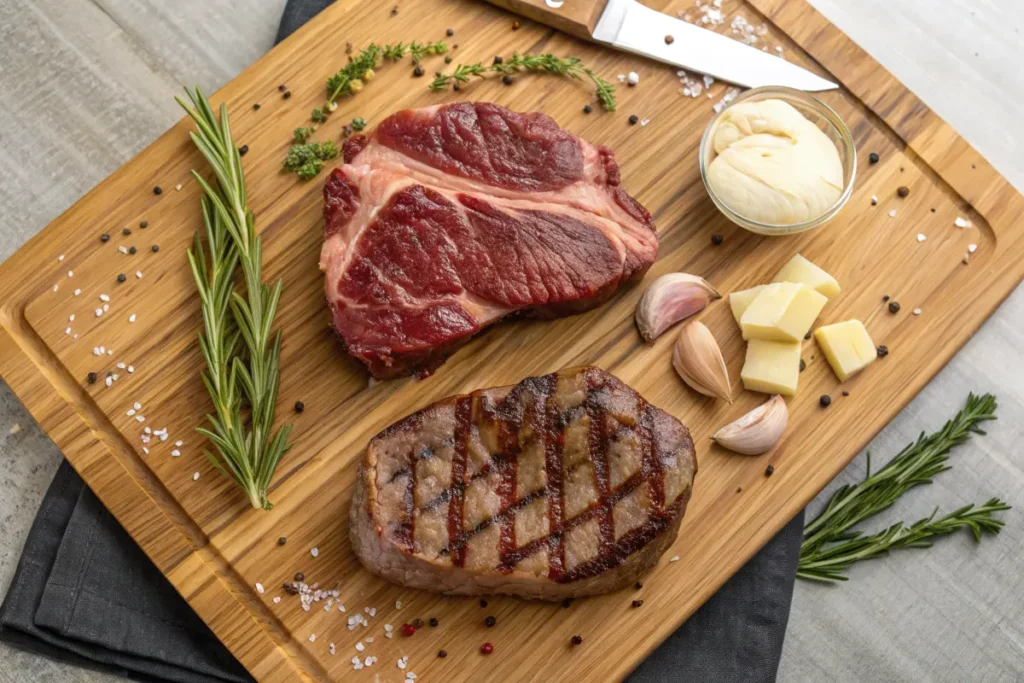
Tips for the Best Steak
- Use a meat thermometer to avoid overcooking.
- Let the steak rest after cooking to retain juices.
- Add butter, garlic, and herbs for extra flavor.
- Avoid pressing down on the steak while cooking, as this releases valuable juices.
Practical Applications: When to Choose Ribeye or Filet Mignon
Deciding between ribeye and filet mignon depends on the occasion, personal preference, and cooking style. Each steak has unique qualities that make it more suitable for certain meals and dining experiences. Understanding when to choose ribeye or filet mignon will help you enjoy the best steak for any situation.
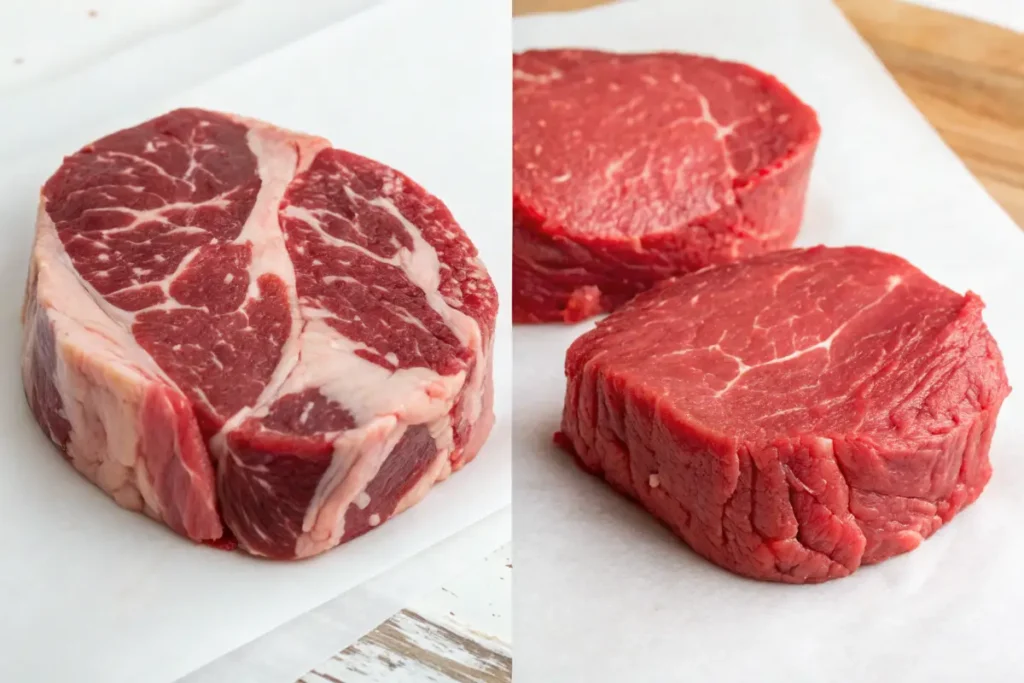
When to Choose Ribeye Steak
Ribeye is the perfect choice when you want a steak that is rich, juicy, and full of flavor. Its high fat content makes it ideal for those who enjoy a bold beefy taste with a tender bite. Here are some occasions where ribeye is the best option:
- Grilling and Barbecues – Ribeye is excellent for outdoor grilling because the fat enhances the smoky, charred flavor. It stays juicy even when cooked over an open flame.
- Casual Steak Nights – If you’re cooking at home and want an easy yet flavorful steak, ribeye is a great choice. It doesn’t require additional ingredients to boost its taste.
- Pairing with Bold Side Dishes – Because ribeye has a rich flavor, it pairs well with hearty sides like loaded mashed potatoes, roasted vegetables, or creamed spinach.
- Serving Multiple People – Ribeye steaks are often larger than filet mignon, making them a great option when serving guests who enjoy a satisfying, meaty meal.
When to Choose Filet Mignon
Filet mignon is best for special occasions or when you prefer a steak that is incredibly tender. Since it is a lean cut, it has a more delicate taste and requires additional seasoning or sauces to enhance its flavor. Here are some situations where filet mignon is the better choice:
- Fine Dining and Elegant Dinners – Filet mignon is a premium steak that is often served in high-end restaurants. Its tenderness makes it ideal for upscale dining experiences.
- Romantic Dinners – If you’re planning a special meal for a date night or anniversary, filet mignon provides a luxurious and refined option.
- Pairing with Light and Elegant Side Dishes – Because filet mignon has a mild flavor, it pairs well with delicate sides like asparagus, risotto, or truffle mashed potatoes.
- Health-Conscious Meals – Since filet mignon is lean, it is a good option for those who want a high-protein meal with less fat.
Choosing the Right Steak for Your Taste
If you love bold flavors and a juicy texture, ribeye is the way to go. However, if you prefer a soft, melt-in-your-mouth steak, filet mignon is the best option. Both cuts offer a delicious experience, and choosing the right one depends on your personal preference and the occasion.
Nutritional Differences Between Ribeye and Filet Mignon
Understanding the nutritional differences between ribeye and filet mignon can help you make an informed choice based on your dietary preferences. While both are excellent sources of protein, they vary in fat content, calories, and other nutrients. The table below provides a comparison of their nutritional values per 3.5-ounce (100g) serving.
| Nutrient | Ribeye Steak | Filet Mignon |
|---|---|---|
| Calories | 291 kcal | 200 kcal |
| Protein | 24g | 22g |
| Total Fat | 21g | 10g |
| Saturated Fat | 9g | 4g |
| Iron | 2.2mg | 2.7mg |
| Cholesterol | 80mg | 70mg |
Key Takeaways from the Nutritional Comparison
- Ribeye steak has more fat and calories due to its marbling, making it a great choice for those who prefer a rich, flavorful steak.
- Filet mignon is lower in fat and calories, making it a better option for people who want a leaner cut without sacrificing tenderness.
- Both cuts provide high-quality protein, essential for muscle growth and overall health.
- Iron content is slightly higher in filet mignon, which is beneficial for maintaining healthy blood circulation.
Tip: If you’re looking for a balance between flavor and health, consider pairing ribeye with lighter sides, such as roasted vegetables, while serving filet mignon with a rich sauce or butter to enhance its taste.
Tips for Choosing and Cooking the Best Steak
No matter which steak you choose, following a few simple tips can ensure a delicious result every time.
- Choose high-quality meat – Look for well-marbled ribeye or fresh, bright-colored filet mignon. A good steak should have a firm texture and no strong odor.
- Use a meat thermometer – Cooking steak to the right internal temperature prevents overcooking and ensures the perfect texture.
- Let the steak rest before serving – Allowing it to sit for at least 5 minutes after cooking helps retain juices, making every bite more flavorful.
- Pair with the right seasoning – Ribeye benefits from simple salt and pepper, while filet mignon pairs well with butter, garlic, and fresh herbs.
- Experiment with cooking methods – Try grilling, pan-searing, or sous vide cooking to find your favorite way to prepare each cut.
Tip: If you want the best of both worlds, consider a surf and turf meal by pairing filet mignon with shrimp or lobster, or enjoy a bone-in ribeye for even more flavor.
Frequently Asked Questions (FAQs) About Steak Choices
Here are 10 common questions comparing different steak cuts, including ribeye vs. filet mignon and other popular options.
Ribeye is known for its rich marbling, which gives it a bold, juicy flavor, while filet mignon is lean and incredibly tender with a mild taste.
Ribeye is better for grilling because its fat content keeps it juicy, even over high heat. Filet mignon is delicate and can dry out easily, so it is often wrapped in bacon or cooked with butter.
New York strip has less marbling than ribeye, making it slightly leaner while still offering good flavor. Ribeye is juicier due to its higher fat content.
Both steaks are similar, but a porterhouse contains a larger portion of filet mignon. If you prefer more tender meat, porterhouse is the better option.
Both steaks are similar, but a porterhouse contains a larger portion of filet mignon. If you prefer more tender meat, porterhouse is the better option.
Skirt steak has more fat and a stronger beef flavor, while flank steak is leaner with a firmer texture. Both are great for marinades and quick cooking.
Wagyu beef has more intense marbling than ribeye, making it even more tender and flavorful. However, ribeye still provides excellent juiciness at a lower price.
New York strip comes from the short loin and has a firm texture with good marbling. Denver steak, cut from the chuck, is more tender than strip steak but has a slightly deeper beef flavor.
Conclusion: Which Steak Should You Choose?
Choosing between ribeye and filet mignon—or any other steak—depends on your personal taste and cooking style. If you love a bold, juicy, and flavorful steak, ribeye is the perfect choice. On the other hand, if you prefer a soft, melt-in-your-mouth texture, filet mignon is the way to go.
For a balanced option, New York strip offers a mix of tenderness and beefy flavor, while Denver steak provides a budget-friendly yet delicious alternative. No matter which steak you choose, the key is to cook it properly and enjoy it with great company.

